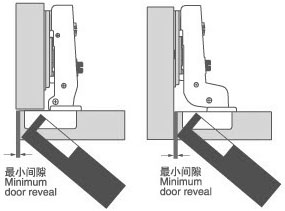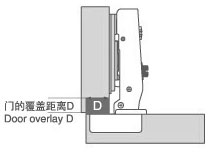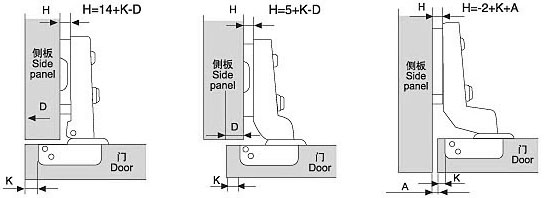How to choose hinges
Mounting options

Full overlay doors
The door is in front of the cabinet side panel providing a small reveal at the side allowing the door to open correctly. Alternatively, the door can be overlaid fully (max. 19mm),in which case sufficient space must be allowed at the side for the required minimum reveal. Use straight hinges, ie, no cranking,(Distance D=19mm).

Half overlay doors
In this case, there are two doors in front of a center panel, with the required overall reveal between them. In other words,each door has a smaller overlay and cranked hinges (Distance D=9mm).

Inset doors
The door is mounted inside the frame formed by the cabinet. Here too, a reveal is needed so that the door can open reliably. Heavily cranked hinges (Distance A=1mm).

Minimum door reveal
The minimum reveal is the space required at the side so that the door can open. The size of the minimum reveal depends on the cup distance K, the door thickness and the type of hinge selected. Radii on the door edges reduce the minimum clearance. The required minimum reveal for each hinge type is shown in the table for the different hinge types.

Minimum door reveal for half overlay
For half overlay designs, the total reveal between the doors must be chosen to correspond to twice the door reveal. Both doors can then be opened at the same time.

K Cup distance K
The cup distance K is the distance between the edge of the door and the edge of cup hole. The larger the cup distance, the smaller the required minimum reveal.

Door overlay D
The over1ay(D)is the distance by which the door projects over the side panel.
Number of hinges per door
Door width, height and weight as the material quality of the door are decisive factors determining the number of hinges required. The factors encountered in each individual case in practice differ enormously. For this reason, the number of hinges shown in the diagram should only be taken as a guide. If in doubt, it is advisable to produce a trial mounting or to increase the number of hinges. For reasons of stability, distance L between the hinges must always be made as large as possible.

General method for calculating distances
Mounting plates are available in different distances (0/2 and 4). The height of the mounting plate is defined H. Distance H is shown on the top of each mounting plate. A larger distance H reduces the overlay D for comer and centre stops. In the case of inset doors, a larger distance H increases the door reveal. To calculate the required distance H, the minimum reveal must first be determined from the table of minimum door reveals for the type of hinge concermed. The minimum reveal depends on the cup distance K and the door thickness. Minimum reveals can be reduced by increasing the cup distance K and/or affixing radii to the door edges. The table of minimum door revea!s also shows the possible combinations of door thickness and cup distance K.
Calculating distance H for overlay doors
Once the minimum reveal A has been defined, the specific distance H can be read off in the table for the required door overlay D and the specific cup distance K. Ideally, the door overlay D and value K should be selected to yield a distance H which is available as a mounting plate. Example: Over1ay=19mm and cup distance K=5mm yield a distance H equal to Omm.This distance is available as a mounting plate. If the calculated distance H differs from the distances available as mounting plates, the difference is compensated by means of the overlay adjustment screw on the hinge arm.
Calculating distance for inset doors
The mounting plate distance H shown in the table for inset doors automatically allows (or the reveal. This minimum reveal is dependent on the cup distance and the door thickness; minimum reveals are shown in a table. If a bigger visible reveal is preferred, then a greater mounting plate distance H must be selected or adjust the distance of cup K Example:K15 Inset. Minimum reveal A=1 mm and cup distance K=5mm, The mounting plate distance read off from the table is 0 mm. This will produce the required minimum reveal of 1 mm. If instead the design requires, e.g.a visible reveal of 3 mm, then the mounting plate distance should be selectedto be 2 mm greater.In the example, this would mean a distance of 5 mm instead of 3 mm, Intermediate distances not available as standard mounting plate distances are achieved via the hinge overlay adjustment.
Explanation for code
H =Height of mounting plate
K =Distance between edge of door and edge of cup hole
D =Distance by which the door projects over the side board
A =Reveal between door and side board
L =Distance from inside edge of door to the outside edge of side board
T=Max.doorthichness
S =Side panel thickness
N =Design standard parameter

Refer to the following formula to choose the arm of hinge, If want to solve the problem, we must know "K" value the distance drilling holes on the door and "H" value the height of mounting plate.
